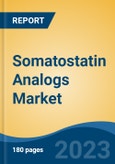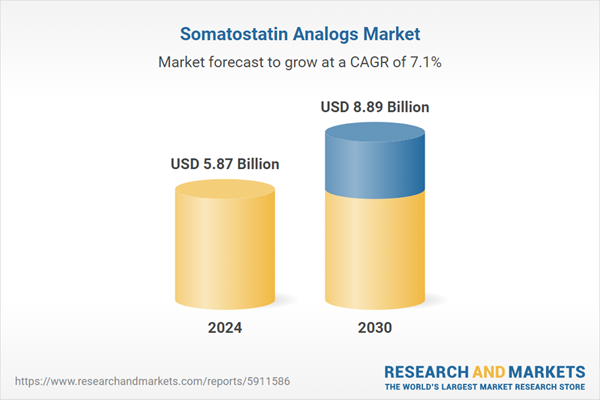Speak directly to the analyst to clarify any post sales queries you may have.
10% Free customizationThis report comes with 10% free customization, enabling you to add data that meets your specific business needs.
One of the key drivers of the Global Somatostatin Analogs Market is the rising incidence of neuroendocrine tumors (NETs), a rare but increasingly diagnosed cancer type. Somatostatin analogs are a cornerstone in the treatment of NETs, as they help in controlling the growth of tumors and mitigating the debilitating symptoms that often accompany these malignancies. Additionally, somatostatin analogs have also found applications in the management of conditions like Cushing's disease and gastrointestinal bleeding associated with portal hypertension, further expanding their market reach.
The market is characterized by the presence of several major pharmaceutical companies, which have developed and marketed various somatostatin analog products. These companies invest heavily in research and development activities to enhance the efficacy and safety of their analogs, driving product innovation. Moreover, strategic collaborations, partnerships, and acquisitions in the industry are facilitating the expansion of product portfolios and geographical reach.
Key Market Drivers
Rising Prevalence of Targeted Diseases
The rising prevalence of targeted diseases is a significant driving force behind the burgeoning Global Somatostatin Analogs Market. Conditions such as acromegaly, neuroendocrine tumors (NETs), and carcinoid syndrome, which are characterized by excessive hormone production and associated symptoms, have witnessed a notable surge in diagnoses. This upward trend is due to improved disease awareness, early detection methods, and a growing understanding of these conditions within the medical community.According to a study, “Epidemiology, Incidence, and Prevalence of Neuroendocrine Neoplasms: Are There Global Differences?”, The overall prevalence of pancreatic NETs (neuroendocrine tumors) was 2.2 cases per 100,000 individuals, with functional tumors occurring at a rate of 1.3 cases per 100,000 and non-functional tumors at 0.95 cases per 100,000. At the time of diagnosis, 21% of pancreatic NETs had already spread to distant sites. For gastrointestinal NETs, the overall prevalence was 3.5 cases per 100,000, with hindgut tumors being the most prevalent. Among gastrointestinal NETs, hindgut, foregut, and midgut tumors accounted for 60%, 30.4%, and 9.6% of cases, respectively. Distant metastasis was noted in 6% of gastrointestinal NETs at presentation. The most common primary sites for these tumors were the rectum, small intestine, and stomach.
One key contributor to the increasing prevalence of these diseases is enhanced screening and diagnostic capabilities. Healthcare providers and medical institutions have become better equipped to identify these hormone-related disorders, leading to earlier intervention and treatment initiation. As a result, patients with conditions like acromegaly and NETs are diagnosed and treated more promptly, spurring the demand for somatostatin analogs.
Furthermore, as the world's population ages, the incidence of diseases associated with hormonal dysregulation, such as acromegaly and certain types of neuroendocrine tumors, is on the rise. These conditions often manifest later in life, and the aging demographic across the globe is contributing to their growing prevalence.
In the case of neuroendocrine tumors, which can affect various organs and have historically been challenging to treat, the use of somatostatin analogs has revolutionized patient care. These compounds effectively control hormone secretion and alleviate debilitating symptoms associated with NETs. As a result, patients are experiencing improved quality of life, and healthcare providers are increasingly incorporating somatostatin analogs into their treatment regimens.
Key Market Challenges
High Treatment Costs
High treatment costs represent a significant obstacle to the growth and accessibility of the Global Somatostatin Analogs Market. Somatostatin analogs, while highly effective in managing conditions such as acromegaly and neuroendocrine tumors, come with a hefty price tag that can be prohibitive for many patients and healthcare systems.One of the primary reasons for the high treatment costs of somatostatin analogs is the nature of these medications. They are typically administered through injections, often requiring frequent dosing. The cost of manufacturing, packaging, and delivering these injections, along with the need for specialized medical supervision, contributes significantly to the overall treatment expenses. For patients who require long-term therapy, the cumulative costs can become overwhelming.
Additionally, the development and production of somatostatin analogs involve intricate and sophisticated processes. Extensive research and clinical trials are necessary to ensure their safety and efficacy, and these costs are typically passed on to consumers. Furthermore, the limited number of manufacturers and the complexity of the drugs themselves can lead to monopolistic pricing, further exacerbating the financial burden on patients and healthcare systems.
The consequences of high treatment costs are far-reaching. Patients who are unable to afford somatostatin analogs may face delays in treatment initiation or may be forced to discontinue treatment prematurely, potentially compromising their health outcomes. Healthcare providers are also burdened, as they must navigate the challenges of securing funding for these expensive therapies within budget-constrained healthcare systems.
Key Market Trends
Drug Delivery Innovations
Drug delivery innovations are playing a pivotal role in boosting the Global Somatostatin Analogs Market. Traditionally, the administration of somatostatin analogs often involved frequent injections, which could be inconvenient and uncomfortable for patients. However, recent advancements in drug delivery technology have transformed the way these medications are delivered, making treatment more accessible, convenient, and comfortable for patients.One of the most notable innovations in this regard is the development of long-acting release (LAR) formulations of somatostatin analogs. These formulations extend the duration of action of the drug, allowing for less frequent dosing. Patients may require injections as infrequently as once every few weeks or even once a month, compared to the daily or multiple times daily injections with traditional formulations. This not only simplifies treatment regimens but also improves patient compliance, as the burden of frequent injections is significantly reduced.
In September 2021, Amolyt Pharma and PeptiDream Inc. jointly announced that Amolyt Pharma had exercised its option to obtain a global license for a portfolio of macrocyclic peptide growth hormone receptor antagonists (GHRA). The licensed portfolio includes the promising drug candidate, AZP-3813, which is currently undergoing development as a potential treatment for acromegaly. AZP-3813 is intended to complement the use of somatostatin analogs (SSAs), particularly for patients who do not achieve satisfactory responses with SSAs alone.
Key Market Players
- Bayer AG
- Novartis AG
- Pfizer Inc.
- Sun Pharmaceutical Industries Ltd.
- Midatech Pharma plc
- Crinetics Pharmaceuticals Inc.
- Peptron Inc.
- Teva Pharmaceutical Industries Ltd.
- Camurus AB
- Mylan N.V.
Report Scope:
In this report, the Global Somatostatin Analogs Market has been segmented into the following categories, in addition to the industry trends which have also been detailed below:Somatostatin Analogs Market, By Type:
- Octreotide
- Lanreotide
- Pasireotide
Somatostatin Analogs Market, By Treatment:
- Acromegaly
- Cushing's Syndrome
- Neuroendocrine Tumors
- Carcinoid Syndrome
- Others
Somatostatin Analogs Market, By End Use:
- Hospitals &Clinics
- Ambulatory Surgical Centers
- Other
Somatostatin Analogs Market, By Region:
- North America
- United States
- Canada
- Mexico
- Europe
- France
- United Kingdom
- Italy
- Germany
- Spain
- Asia-Pacific
- China
- India
- Japan
- Australia
- South Korea
- South America
- Brazil
- Argentina
- Colombia
- Middle East & Africa
- South Africa
- Saudi Arabia
- UAE
Competitive Landscape
Company Profiles: Detailed analysis of the major companies present in the Global Somatostatin Analogs Market.Available Customizations:
With the given market data, the publisher offers customizations according to a company's specific needs. The following customization options are available for the report.Company Information
- Detailed analysis and profiling of additional market players (up to five).
This product will be delivered within 1-3 business days.
Table of Contents
Companies Mentioned
- Bayer AG
- Novartis AG
- Pfizer Inc.
- Sun Pharmaceutical Industries Ltd.
- Midatech Pharma plc
- Crinetics Pharmaceuticals Inc.
- Peptron Inc.
- Teva Pharmaceutical Industries Ltd.
- Camurus AB
- Mylan N.V.
Table Information
| Report Attribute | Details |
|---|---|
| No. of Pages | 180 |
| Published | February 2025 |
| Forecast Period | 2024 - 2030 |
| Estimated Market Value ( USD | $ 5.87 Billion |
| Forecasted Market Value ( USD | $ 8.89 Billion |
| Compound Annual Growth Rate | 7.1% |
| Regions Covered | Global |
| No. of Companies Mentioned | 10 |









